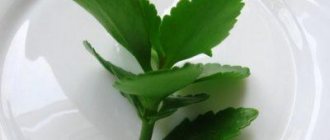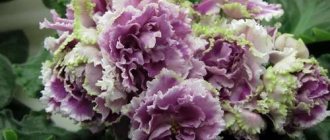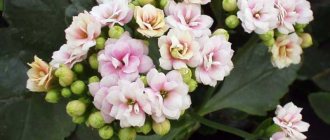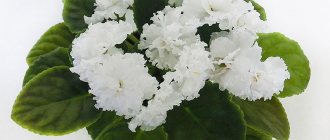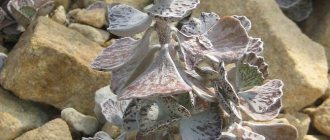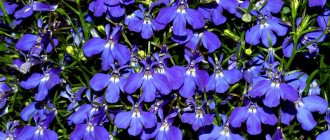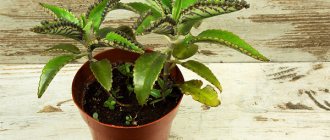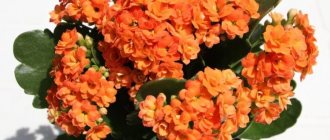Characteristics and description
Kalandiva is a very tenacious and undemanding plant, like other species.
Its main advantage is lush flowering for a long time.
If conditions are favorable, it can last six months.
Another feature is that it blooms in winter , often blooming on New Year's Eve.
As
a succulent, it has thick, rounded stems densely covered with fleshy leaves.
The shoots are numerous, branch well and produce aerial roots. The leaf blades are painted in a thick dark green color, their surface is leathery and glossy. The shape is round or ovoid, the edges are cut into small, frequent teeth.
The inflorescences are double , located on a short peduncle, folded into lush umbrellas.
The color is quite varied, including pink, orange, purple, red, yellow and beige shades.
Mix is a descendant of Kalandiva mini , its hybrid. The main difference from the parent is that flowering can continue without interruption all year . There are no special care requirements.
Diseases and pests
If the conditions are not created correctly, the plant may become sick:
- Rot occurs with excessive watering and the absence of the first watering after transplantation. To get rid of the disease, the rotting parts are cut out to healthy tissue and the plant is treated with an appropriate fungicide. If decay has affected a large part, then it is updated using cuttings.
- Spots on the leaves occur due to lack of nutrition. It is necessary to increase watering with warm water and feed the plant.
- Yellow leaves - lack of sunlight and moisture during watering.
If harmful insects are detected, the plant is moved to a quarantine zone and treatment begins - mechanical removal of pests from the leaves and trunk and treatment with Actellik will be required.
Photo
Description of the variety Kalanchoe Blossfeld 'Kalandiva'
First, a little history about the flower variety. Kalanchoe Blossfeldiana 'Calandiva' was developed by Dutch breeders in 2002 and is the first artificially bred variety of Kalanchoe. In the beginning they called him Leonardo. Later, several more varieties were bred with different colors and shapes of flowers - double, single and garden varieties. They all had their own names - Calanday®, Grandiva® and Calandiva®. But in 2022, the creators of these wonderful varieties decided to combine all their varieties and sell them under one brand - Calandiva®.
Photo of one of the varieties of Kalanchoe Kalandiva (flickr.com)
Kalanchoe Kalandiva is an evergreen succulent plant with a slow growth rate, usually growing from 30 to 45 cm in height and from 10 to 50 cm in width. The shoots are bare, directed vertically. The shiny, wrinkled foliage retains its green color throughout the year.
The main advantage of this succulent is its flowers. Among all the diversity of Kalandiva, you can find varieties with different flower shapes, similar to roses or violets. There are varieties with different numbers of petals - 4, 8, 16 or even 32. Flowers can be pink, burgundy, orange, red, cream, purple and yellow in other colors. This feature makes 'Calandiva' a unique houseplant.
The flowering time of Kalanchoe Kalandiva lasts from six to eight weeks in good conditions. You can expect flowers to appear in late winter or early spring.
Despite the fact that some species of Kalanchoe have medicinal properties, Kalandiva is not one of them and is not used as a medicinal plant.
Care
Temperature
Regular room temperature between 22-27° is quite suitable for Kalandiva.
It tolerates short-term temperature drops of up to 6-9° and any heat, up to 40°.
Light mode
If you want to achieve long-term flowering, place the African guest on a south window.
Kalandiva loves light very much and is not afraid of direct rays of the sun.
Being on the eastern and western sides of the house, it does not form inflorescences.
In addition, the shoots will begin to stretch and thin, the leaves will be located far from each other, greatly exposing the stem. Kalandiva will completely lose its attractive appearance.
Watering
As a succulent , it does not tolerate frequent watering and plenty of water.
Constant soil moisture will provoke an attack of fungal diseases , causing rotting of the roots and stems. Drought will harm the plant much less, so do not overwater the plant.
It is quite enough to moisten the soil every 6-8 days, even in summer. In any case, you need to wait for the soil on top to dry.
Immediately after watering, the water that has leaked into the pan must be poured out. Experienced flower growers even recommend wiping dry both the bottom of the pot and the tray.
For irrigation, use only softened water with a minimum amount of lime.
To do this, tap water must be settled or boiled, or melt and rain water must be used. Otherwise, a coating will form on the surface of the earth, which will prevent the passage of air to the roots.
If kept in a cool room in winter, watering is further reduced, increasing the interval between procedures by 5-7 days.
Don't worry - it won't hurt him. But excess moisture will almost certainly cause rotting of the roots and base of the stems.
Humidity
Kalandiva does not need high humidity.
Do not spray it or place a container of water next to it. It is quite enough to occasionally wipe the leaves from dust or take a cool shower for the same purpose.
Dust clogs the stomata through which the plant collects moisture and interferes with its normal development.
Top dressing
The most necessary fertilizers, especially during flowering, are potassium and phosphorus. They should be applied regularly - individually or in combination.
The interval between feedings is standard - from 10 to 15 days.
But fertilizing with organic matter or not use it at all, since it contains a lot of nitrogen.
This substance causes the flower to fatten, it begins to intensively grow green leaves and shoots, and forgets about flowering.
At best, you can get a few stunted inflorescences that will soon fall off.
The soil
The main condition is good permeability of water and air, so it is advisable to use loose soil with drainage additives.
A mixture of peat, sand, humus, garden soil and perlite is perfect. You can also buy ready-made soil - universal or special for succulents and cacti.
Bloom
Kalandiva begins to bloom during short daylight hours - in winter.
With proper maintenance, this can last 6-7 months.
After which the plant should rest for about a month in a dark room.
Calandiva can be put under the table or in a closet and left alone, occasionally watering it so that it does not dry out.
Trimming
This procedure is very important for Kalandiva!
Pruning rejuvenates the plant, gives it an elegant decorative shape, and helps obtain planting material.
In addition, the operation ensures lush flowering in the future, because inflorescences are formed only on young apical stems. Pruning is carried out immediately after flowering, using a well-sharpened tool.
The shoots can be cut off almost entirely, then the new ones will form a nice little bush.
Transfer
Immediately after purchase, it must be replanted into real soil - in the store, plants are kept in temporary soil that has no nutritional properties.
If Kalanchoe blooms , it is recommended to wait until the process is completed.
After removal from the pot, the root system is washed under running water to completely wash away the remnants of the store-bought substrate.
Subsequent transplants do not have to be carried out every year, since it does not grow large.
It is quite enough to replant the plant after 2-3 years, completely replacing the soil with new one.
Since the mix species is a hybrid of Kalandiva , care at home is no different.
Plant selection and care after purchase
Kalanchoe in full bloom looks beautiful, but this means that the corollas will wither in less than a month. Kalandiva is often used as a bouquet plant; after the first, most abundant flowering, it is thrown away without bothering with further care.
It is better to take Kalanchoe with buds - from them you can understand what the color of the corollas will be. If you care for it correctly and choose a place, the bush will not lose its decorative effect for 2-3 months.
Leaves should be:
- elastic;
- juicy;
- thick;
- no spots, dots, dry areas.
It’s good when buyers do not hesitate to ask the seller to remove the plant from the pot:
- the room should smell fresh;
- roots – white, cream, light brown;
- There are no signs of rot.
It is acceptable for Kalanchoe Kalandiva to have a small amount of dry roots - it is, after all, a succulent. Temporary dryness of the coma is not scary for him, but some sucking shoots may die off.
After purchase, the bush is placed separately from the main collection. Observe whether the plant shows signs of pests or diseases.
Transplanting flowering Kalanchoe is not recommended:
- A simple transfer to a larger pot will calm the owners, but is useless for Kalandiva. Undisturbed roots “pupate” in the transport substrate and reluctantly germinate into fresh soil.
- If you free some of the lower shoots from the old soil, they will certainly be injured. It will be difficult for Kalanchoe to maintain flowering and regenerate its roots at the same time. As a result, Kalandiva will gradually drop its buds due to damage to the underground part and will be sick for a long time
- A complete transplant must be accompanied by the removal of all buds.
Let Kalandiva bloom quietly, and you can replant the bush later. If the plant is healthy, the conditions are correct, nothing will happen to it.
Reproduction
Reproduction in general does not cause any difficulties or worries, since Kalandiva reproduces very readily. The most dubious and time-consuming method is the seed method, but it is practically not used.
After all, Kalandiva is a hybrid plant and does not transmit varietal qualities when propagated by seeds.
Much more often they use stem cuttings remaining after pruning the plant. Often they already have roots, so they do not require rooting.
The cuttings simply placed in a loose substrate of peat , sand, vermiculite and humus and watered as usual. Cuttings without roots are covered with half a plastic bottle to create a greenhouse effect for quick rooting.
The greenhouse is removed when active growth of the seedling begins, indicating the success of the procedure. The grown seedling is moved to good soil.
Propagation by leaves takes a longer period and is no different from cuttings.
Caring for a plant at home
Even a novice gardener can grow Kalandiva.
Watering and fertilizing
Kalanchoe should be watered with caution, as the roots begin to rot due to the abundance of moisture. In summer and spring, the procedure is carried out only after the surface of the earth is completely dry. There should be just enough water to moisten the soil; liquid should not drain into the pan. In the autumn-winter period, watering is reduced to 1 time per week.
Use water at room temperature only! Too cold or warm can cause root rot.
Kalanchoe should be watered sparingly and only with water at room temperature.
Kalandiva requires a minimum of fertilizers; if there is an excess of minerals, the plant refuses to bloom. Fertilizing is applied 2 times a month from late spring to July. The rest of the time the procedure cannot be performed. Use mineral fertilizers for succulents, reducing the dosage indicated on the package by half.
All fertilizers are applied only in liquid form. If you bought the powder, thoroughly dissolve it in water.
How to cause flowering and what to do after it?
The flowering time begins in February - March. This period can last from two months to six months. For it to start, you just need to observe the light regime. There is no need to reduce watering or increase the amount of fertilizer applied.
Possible problems in growing the Kalandiva variety
Plants that are not harmed by diseases and pests do not exist in principle. Even if they are grown at home, there is a risk that the flowers will contract some disease or suffer from small insects.
In the case of Kalandiva, common diseases that affect the flower are rot and powdery mildew.
The causes of rot are oversaturation of the soil with moisture and the plant being in the cold. As a result, the leaves and shoots turn black at the base, or yellowness appears on them, and brown spots appear.
Note! Powdery mildew is identified by a whitish coating on the leaves. This disease is the result of cold drafts and high humidity.
In each case, it is necessary to place the plant in a favorable place, remove the affected parts, and treat it with medicinal agents.
Aphids are brought onto the flower either by nearby infected plants, or they enter the house from the street through an open window. You can notice a cluster of small insects on leaves, buds and shoots. The flower should be moved to a separate place away from healthy specimens. Further treatment consists of washing the leaves with liquid laundry soap, showering, and using insecticides: inta-vir, decis, fasa.
Flowers in the house mean harmony and comfort. If this is a plant with a long flowering period, then this is the most successful option for the home interior. Kalanchoe Kalandiva will be a wonderful decoration. His presence in the house is a real blooming holiday.
Kalanchoe Kalandiva - what kind of flower is it?
The plant itself is from the Succulent family. It has dense, fleshy leaves and stems in which water and nutrients accumulate.
Numerous shoots have an erect and bare appearance. The leaves are dark green. The outer surface of the leaf is glossy, ovate, with slightly jagged edges. The leaf reaches 4–6 cm in length. The foliage on the stem is located opposite.
Calandiva - a flower unlike other species of the family
For your information! The plant blooms for almost 8 months. This is its special property. The inflorescences are small and brightly colored; they look like terry balls.
How to make your Kalandiva bloom
As mentioned above, the flowering time of this Kalanchoe variety is 6-8 weeks. This period may vary slightly depending on how healthy the plants were when you bought them and how warm your home is. As with any flowering plant, the hotter it is in your home, the faster the flowers will bloom and the shorter the flowering period will be. Getting them to bloom again is not an easy task. The fact is that these plants are photoperiodic.
Photoperiodism is the reaction of living organisms (plants and animals) to the daily rhythm of illumination, the length of daylight hours and the relationship between dark and light times of day (photoperiods). (Wikipedia)
In this case, this means that Kalanchoe Kalandiva requires about 14 hours of darkness throughout the late fall and winter to bloom again. This is when the buds develop. If possible, keep indoor plants away from artificial light in winter. Put them in a closet or dark room from evening until morning. It is also worth reducing the frequency of watering or not watering at all. Once you notice small buds forming, you can stop moving the flower. The first buds can be expected as early as January. When you bring it back from the dark, you need to feed it with water-soluble fertilizer diluted to half the dose indicated.
And at the end, we suggest watching this video, where you will additionally become familiar with the nuances of caring for Kalanchoe Blossfeld Kalandiva.
Medicinal properties
If you were able to provide good care at home for Kalanchoe Mix, then it will definitely become an excellent helper for you.
Kalanchoe is not only a beautiful, but also a very useful indoor plant. Kalanchoe juice is used in many areas of medicine. It is used to treat various gynecological diseases, as well as in dentistry. The juice perfectly heals various wounds and ulcers, eliminates the effects of frostbite and is especially often used to treat serious burns. It can also be useful for tonsillitis and stomatitis. Kalanchoe can safely be called a home first aid kit, since it can help out in various situations in the absence of the necessary drugs.
Temperature
You may be interested in:Venus flytrap: how to care for the plant at home
Kalanchoe is not one of the capricious plants and feels absolutely normal at any temperature in the room. But this does not mean that you can put it on the balcony in winter. In summer, the air temperature in the room should not fall below 18 degrees and rise above +28 °C. In winter, the flower can easily tolerate a drop in temperature to +14 °C. It is worth considering that if the air temperature in the room is below ten degrees with a plus sign, then there is a high probability that the plant will become very sick, and perhaps even die. Also note that at low temperatures, buds begin to appear on the plant.
Transfer
Young Kalanchoe (no older than 3 years) must be replanted every year, an adult - only once every 3-4 years. Also, after purchase, this indoor flower must be transplanted into new soil, but if it blooms, then it is better to postpone the transplantation.
Choosing the right pot and soil
Each time you need to take a pot a little larger than the previous one. If the same container is used, it must first be thoroughly washed to remove any adhering soil and scalded with boiling water to disinfect it.
Drainage is placed at the bottom of the container - a layer of expanded clay, pebbles mixed with coarse sand. It is advisable to take ready-made soil for Kalanchoe Kalandiva, intended for use under succulents or cacti. You can also make it yourself from a mixture of sand, turf and peat soil, non-acidic peat and good humus in equal parts.
Step-by-step transplant process
Kalanchoe Kalandiva is transplanted in early spring. For this:
- Water the plant to wet the soil.
- Prepare a new pot, fill it with drainage and soil.
- 15 minutes after watering, remove the bush along with a lump of earth.
- Place the flower in new soil, lightly water it and sprinkle soil on top.
The pot is placed in partial shade for 3-4 days. After this, they transfer it to the place where it will grow.
How to stimulate flowering?
In the case when the Kalanchoe does not bloom well or refuses to do so at all, you will have to do some care that will help it bloom.
When the Kalanchoe has bloomed, remove all faded peduncles and upper leaves in the place where the inflorescences were located.
A common problem with poor flowering is improper thermal conditions. To solve this problem, in winter, the flower pot is moved to a cool place, while providing the Kalanchoe calandiva with the required amount of lighting and watering.
In some cases, to stimulate bud formation at home, you will have to replant the Kalanchoe.
